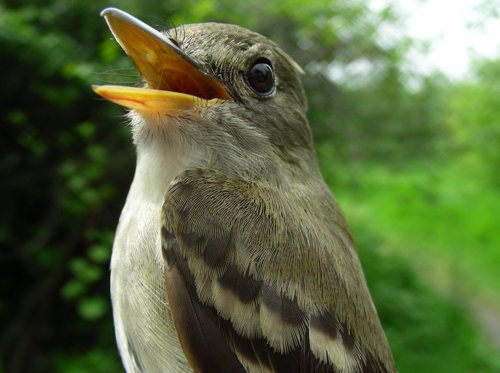|
McGILL BIRD OBSERVATORY |
|||||||||||||||||||||||||||||||||||||||||||||||||||||||||||||||||||||||||||||||||||||||||||||||||||||
Welcome
to the McGill Bird Observatory weekly report.
Click here for a complete listing of our archives.
Bander-in-charge: Marie-Anne Hudson Notes: Despite losing a day and a half to bad weather, we managed to band 56 birds in our final week, which was only supposed to comprise three days of banding anyway, as per our standard 45-day spring banding season. The rest of the week has consisted of census only. We have finished our 2008 spring season with 10 more birds than at this time last year, for a total of 828 birds banded of 64 species: 124 birds and four species more than last year. Migration was still going strong early in the week, with three new species added to the season list: Blue-gray Gnatcatcher (a new species for the site, let alone year and season), Alder Flycatchers singing everywhere, and Great Black-backed Gull (which was the only species seen in March but not during the spring season – the season and yearly totals are now the same). We even managed to band a new species for the season and year: Yellow-bellied Flycatcher. Over the last three days of the season, however, numbers dropped dramatically, with residents quickly taking over the morning chorus. Highlights this week include Jean’s chattering Blue-gray Gnatcatcher on census, a species no one had predicted for the next new species at MBO. It’s too bad it was hanging out so far from any of our nets, because we would have happily banded it as our 106th species, but perhaps next season? A surprisingly late Ruby-crowned Kinglet was another nice little visitor, giggling away past the B/N nets on a very rainy day. The last day of the season, three Wood Thrushes were heard singing pas the B/N nets, well inside the Arboretum. We hope they’ll continue to sing throughout the summer, as deciduous woods without Wood Thrush song are sad woods indeed. This week’s top 10 banded species list is less of a top 10 and more of a “here’s pretty much everything we banded this week” table. The continued influx of Cedar Waxwing had us scratching our heads, as we were pretty much convinced it was the same flock of 20 birds circling around and around. Well, with a total of 29 birds banded in less than two weeks and not a single recap, our minds have changed and there are likely well over 40 in various flocks. Bird counting isn’t always straightforward, and cases like this illustrate how banding can provide more accurate estimates of migrant numbers! The Blackpoll Warblers were around late into the week, and an additional seven were banded in just 1.5 days of banding, tied with our local Red-winged Blackbirds, most of which either have giant brood patches or cloacal protuberances. Strangely enough, it was only the day after we banded five Traill’s Flycatchers that they started singing, enabling us to guess that our Traill’s were actually Alder Flycatchers. Unfortunately none sang in the hand so the best we can do is speculate. The rest of the list consists of both migrants and breeders with just a few banded of each one, a very similar pattern to last year at this time, and one that justifies our choice of end date for the season. This week’s top 10 observed species list has again been shuffled, with last week’s top species down near the bottom and vice versa - with the exception of the Red-winged Blackbird. This list is very similar to last year’s and reflects the major breeders in the area, though would likely be a little different if we hadn’t had so much rain this week. The re-entrance of the Song Sparrow indicates a possible resurgence in territorial singing, and certainly the entrance of the European Starling to the list is only due to the massive number of extremely raucous young chasing their parents around the site on June 3rd.
We finished the season with 139 species observed, up four from last year. More detailed summaries and analyses of the spring data will be presented in the full seasonal report, due out within the next month. Watch for our monthly summer updates at the end of June and July; weekly updates will resume with the start of the Fall Migration Monitoring Program in August. Here’s a sneak peak of the spring summary:
The table above provides a brief preliminary summary and comparison with previous spring migration monitoring seasons at MBO. It reflects both the consistency and inter-year variability that we have noticed throughout the season. Five of the species (Red-winged Blackbird, Ruby-crowned Kinglet, American Goldfinch, Yellow-rumped Warbler, and Yellow Warbler) have been among the 10 most frequently banded birds each of the three years. However even these species vary considerably in abundance from year to year - for example, the number of Ruby-crowned Kinglets was identical in 2006-2007 but increased this year, while Red-winged Blackbirds decreased by roughly the same number from last year. The most notable changes this year, however, were the large number of White-throated and Eastern White-crowned Sparrows remaining late into the season, as well as the influx of Wilson’s Warbler. We have only banded at most 15 during one spring season (2006) so their migration late in the season was quite marked. For more analysis of these and other patterns, stay tuned for the full spring report! We’d like to thank all our censusers, net assistants, extractors, banders-in-training, supporters and birdathoners for the best spring season yet! We’ll be continuing with summer censuses two to three times per week to keep tabs on our breeders, so if you’d like to participate, please let us know. Happy summer to you all!
|



